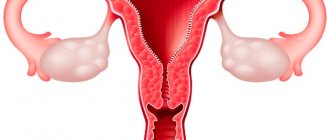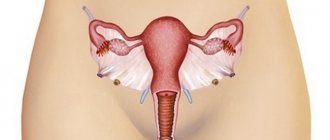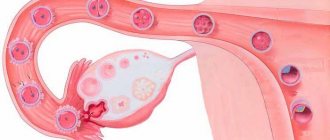Diseases of the female reproductive system are quite common today. Many of them are dangerous and can appear at absolutely any age. Erosion is often diagnosed in pregnant women. The pathology is insidious, as it proceeds hidden for a long time. Changes in the mucosa are detected upon examination. The disease, if not treated, is fraught with problems with conception, cycle disorders, and also pregnancy. There is also a risk of malignancy.
What kind of disease is this
Erosion means damage to the mucosa, in which epithelial tissue is replaced by cylindrical tissue. Over time, the changed layer, thanks to reserve cells, is replaced by a flat one.
The cervical area is considered the most vulnerable; it is the area that is more susceptible to the appearance of formations. In appearance, erosion is similar to a red spot that stands out against the background of unchanged mucosa. Damage to epithelial tissue is accompanied by its exposure and bleeding. Pathogenic microflora easily penetrates the uterine cavity, which leads to infertility and other consequences.
Not a single woman is immune from the development of pathology. It is possible that cervical erosion may occur during pregnancy.
According to statistics, the disease is more often detected in girls under 25 years of age. In old age, changes in the mucous membrane are almost not observed.
Types of erosion
There are several types of pathology. They differ in the time of appearance, symptoms and consequences. Any type of erosion, especially during pregnancy, requires treatment. Otherwise, the risk of complications is high.
Table - Types of mucosal damage
| View | Characteristic |
| Congenital | Development occurs in utero. The changes occupy a small area. These appear to be red spots. It is often detected in childhood and adolescence. The condition does not require special therapy. All you need is a doctor's supervision |
| True | Looks like a bright red wound surface. Accompanied by inflammation and bleeding of ulcers (during intimacy, examination by a doctor). After approximately 15 days, this type of pathology transforms into ectopia or pseudo-erosion. This disease is characterized by the appearance of ulcers of different diameters on the cervix. The surface of the ulcerations is uneven and scarlet in color. Erosion can affect the deep layers of the neck. This is fraught with the formation of hollow passages, which, after filling with secretions, turn into cysts |
| Pseudo-erosion | A girl can live with changes in the cervix for many years, since it is often asymptomatic. The formation of atypical cells due to erosion is fraught with oncology. It is this type that requires therapy, taking into account the stages and accompanying changes. |
Why is erosion dangerous during pregnancy?
It should be understood that in most cases, pregnancy against the background of erosion proceeds normally, but sometimes there are cases when pregnancy worsens the degree of dysplastic processes in it, because erosion is a good background for the development of infection. In this case, the wound surface becomes infected, it melts and the infection spreads to the amniotic sac, which leads to premature rupture of amniotic fluid and termination of pregnancy or premature birth. In addition, it can cause the development of ICI, ruptures during labor and bleeding.
Subscribe to news
Simplify your life - our newsletter will be useful to you.
Causes
The occurrence of erosion during pregnancy in the cervix is determined by various factors. Scientists believe that organ damage is associated with early sexual life and its excessive activity. Until the age of 20, the mucous membrane is considered not fully formed and any damage is fraught with the development of erosion. The disease is also provoked by:
- decreased protective properties of the body;
- hormonal imbalance;
- sexually transmitted infections;
- long-term use of oral contraceptives;
- frequent change of partners;
- genetic predisposition;
- trauma to the mucous membranes (abortion, miscarriage, difficult childbirth).
Ectopia on the cervix can be caused by the presence of formations in the organs of the reproductive system, stress, and overexertion.
The exact cause of the disease can be determined by the doctor after collecting anamnesis and conducting a thorough examination. Only after this the method of therapy during pregnancy is selected.
The effect of erosion on pregnancy
In itself, such a pathology does not affect the pregnancy of the baby in any way and is incapable of harming it. The main thing is to exclude the presence of cancer cells in time! However, if the cause of ectopia is various infections (chlamydia, gonorrhea, herpes, papillomavirus, trichomoniasis and others), then things are completely different.
Such viral diseases can pose a threat of miscarriage or premature birth. Thus, bacteria can infect the membrane of the amniotic sac and cause it to rupture. During the process of childbirth, it is worth remembering that a damaged cervix is less elastic and problems with its proper opening may also arise.
Symptoms
Doctors strongly recommend that you undergo regular examinations, since there are diseases that occur hidden, but at the same time greatly harm the reproductive and reproductive systems. One of these is considered to be erosion on the cervix during pregnancy.
The pathology is not characterized by severe pain or discomfort. It is accompanied by light bleeding. Erosion may bleed during pregnancy after medical procedures or sexual intercourse. The occurrence of the following signs should alert you:
- profuse leucorrhoea with a yellowish tint and an unpleasant odor;
- burning and itching;
- pain in the abdomen;
- heavy bleeding.
This symptomatology signals the addition of an infectious process, which is extremely dangerous during pregnancy. Therapy is prescribed after diagnosis.
When to get pregnant after treatment for erosion
After a woman gets rid of the disease, a recovery period begins. At this time, doctors strongly do not recommend getting pregnant or even having sex:
- With electric current therapy, scars heal within 1.5–2 months. Therefore, there can be no talk of conception before this period.
- Laser coagulation is less traumatic and allows you to recover within a month from the date of surgery.
- Cauterization using ultra-low temperatures involves a one and a half month recovery course in combination with outpatient treatment. Pregnancy can be planned after this period.
- Chemical coagulation and radiosurgery require abstinence for 30 days, which is necessary for the formation of a healthy layer of epithelium on the walls of the cervix.
Is it possible to give birth with cervical erosion?
Rarely do girls who are diagnosed with damage during pregnancy undergo radical treatment. Therapy is prescribed if indicated. If a woman suffers from severe symptoms, a technique will be selected for her. When the pathology is not complicated by symptoms, doctors take a wait-and-see approach and postpone surgical methods to eliminate the defect until the postpartum period.
Often, childbirth with erosion in the cervix proceeds normally. The woman does not experience organ ruptures. The pathology also does not affect the development of the baby. But this is only in the case of an unadvanced disease. When the ulcer is extensive and accompanied by severe symptoms, this is fraught with premature birth, miscarriage, and organ injury.
The best way to prevent complications is to plan pregnancy after removal of cervical erosion. Doctors advise starting treatment immediately after detection. The sooner the mucous membrane becomes normal, the lower the risk of negative consequences, including degeneration into cancer. According to many patients, pregnancy after healing of cervical erosion occurred in about two to three cycles.
Possible complications
The course of pregnancy with cervical erosion should be monitored by a doctor. Examinations are carried out regularly, this is due to the risk of complications in a woman during pregnancy and after childbirth. The list of possible ones includes:
- early miscarriage;
- premature birth;
- proliferation of erosive foci due to the growth of the uterus;
- dysplasia;
- an increase in lesions due to injuries received during childbirth.
Only timely detection and supportive therapy can provide prevention. The appearance of consequences for a woman during pregnancy. The most dangerous complication is dysplasia; the condition is classified as a group of precancerous lesions, so its treatment should be given due attention.
Erosive lesions of the cervix do not pose a danger to the mother and child; the danger lies in possible complications. To minimize the effect of negative factors, a woman at the stage of pregnancy planning needs to undergo a full examination in order to weigh all the risks present.
This article is posted for educational purposes only and does not constitute scientific material or professional medical advice. Always trust your doctor first!
Diagnostics
In order to confirm the diagnosis, the doctor, in addition to questioning, collecting complaints and anamnesis, and an extended gynecological examination, prescribes:
- Colposcopy. One of the most accurate research methods, allowing you to study the condition of the mucous membrane and determine the boundaries of the lesion.
- Biopsies. It involves pinching off a piece of cervical tissue for further histology.
- Collecting a smear. Specific diagnostics to identify atypical cells.
- Colpomicroscopy. With this study, you can study the mucous membrane under magnification up to 300 times.
Only after a thorough diagnosis and the exclusion of malignant degeneration is therapy prescribed.
Redness around the cervix - what is it?
The cervix plays a key role in the process of conceiving a child. After all, this is a kind of gateway to the uterus.
It performs important functions:
- produces mucus, which affects the ability of sperm to move freely in the direction of the fallopian tube, where fertilization of the egg should occur;
- influences the process of gestation, preventing the premature onset of labor;
- prevents rapid labor.
Erosion is an ulcer, a wound on the epithelium of the cervix. It occurs due to the inflammatory process in the female organs. A doctor can detect it during a routine examination in a gynecological chair. However, such a diagnosis is not made “by eye”. Redness around the cervix may also indicate ectopia (pseudo-erosion).
Ectopia is a normal physiological condition that occurs in every third woman. Redness during ectopia goes away on its own and does not require treatment. Ectopia also does not affect conception in any way.
However, some doctors of the “old school” do not differentiate between erosion and ectopia, sending the patient for cauterization “without trial.” Although true erosion is much less common than ectopia.
Remember: before making such a serious diagnosis, the doctor must do a colposcopy - an examination of the vaginal mucosa using a special device.
Colposcopy is done on a gynecological chair. If colposcopy confirms the diagnosis of “true erosion,” sometimes it is also necessary to perform a biopsy (examination of a piece of tissue under a microscope) to exclude a malignant process.
Is it always necessary to treat?
Therapy is not required if the erosion on the cervix is physiological, that is, it formed before birth (with the development of the mucous membrane). With age, around the age of 30, the vulnerable area is closed with full-fledged squamous epithelium and treatment is not required.
The need for therapy arises with pseudo-erosion, which often occurs with complications and is prone to malignancy.
ethnoscience
Traditional medicine offers treatment methods based on the use of medicinal plants. During treatment, you need to monitor your health; herbs can provoke an allergic reaction.
For local use (lotions, tampons, baths), it is recommended to make decoctions of the following herbs:
- aloe;
- oak bark;
- calendula;
- celandine;
- pharmaceutical chamomile.
Lotions with pumpkin pulp are effective. Erosion can be treated using honey or propolis. But herbs such as St. John's wort and aloe, despite their high healing effect, can harm a pregnant woman. The side effects of these plants are dangerous for a woman expecting a baby.
Before you start using traditional medicine recipes in treatment, you should consult your doctor. Some herbs have side effects and should not be used during pregnancy.
What treatments are acceptable?
The treatment tactics for cervical erosion during pregnancy depend on the development and complexity of the process. If the lesion is not severe, doctors carry out therapy only after childbirth. Almost all radical methods have side effects and are associated with the risk of complications. That is why erosion is either not treated until the woman gives birth, or conservative tactics are used. During pregnancy, the following medications may be prescribed:
- Hexicona, Fluomizina. Effective for infections accompanied by heavy discharge. In the second trimester of pregnancy, the use of Terzhinan and Neo Penotran may be prescribed.
- Sea buckthorn suppositories. Helps eliminate itching.
- Viferona. Strengthens the immune system.
- Vagilak, Lactagel. To normalize the balance of vaginal microflora.
Cauterization with radio waves
A popular method that is not recommended for use in the treatment of cervical erosion in girls of reproductive age. Used for chronic recurrent inflammation. Since a scar remains after the intervention, this area hardly stretches, which means it can rupture during childbirth.
Electricity
One of the most aggressive and traumatic methods of erosion therapy. This method, due to the appearance of large scars and scars, is contraindicated for girls with unrealized motherhood.
Nitrogen
A common technique that is allowed to be used by women planning a pregnancy. Thanks to the targeted and non-aggressive effects of liquid nitrogen, as well as the doctor’s compliance with all the rules during the procedure, no scars remain on the previously affected area.
Laser
The method is the least aggressive and carries almost no risk of scarring. But even this method is rarely resorted to when carrying a fetus - only when the pathological process is significantly pronounced.
Other methods
During pregnancy, the doctor may recommend the use of traditional methods of treating erosion in the cervical mucosa. Herbal medicines have a pronounced healing effect and help in curing pathology. In order for the products to bring exceptional benefits to the body, you need to use them correctly - adhere to the proportions and dosages.
Recipes for effective compositions:
- Dried, crushed yarrow (20 g) is brewed in 500 ml of boiling water. The container is placed in a warm place for an hour. The infusion is used for douching. The procedure is carried out once a day, in the evening.
- Tampons with pumpkin are effective during pregnancy and cervical erosion. The pulp of the vegetable is wrapped in a bandage and inserted into the vagina overnight. To get rid of minor erosion, 5 procedures are enough.
- Propolis is useful for illness. For therapy, a tincture of bee glue is used. The medicine is mixed with water in a ratio of 1:2. Then a tampon is soaked in the liquid and inserted into the vagina overnight.
There are many remedies for treating erosion at home. It is not recommended to use them without first consulting a doctor. This can lead to unpredictable consequences.
Diagnostic procedures
If during a visual examination the gynecologist discovers erosion, additional diagnostics will be required, which will not only confirm the diagnosis, but also help establish the cause.
In order to check whether there are any germs and bacteria in the body, a smear is taken from the woman for analysis. An examination using a colposcope will determine the nature of the formation, as well as assess the risk of degeneration into a cancerous tumor. This diagnostic method is used during pregnancy if the symptoms of the disease are clearly manifested and the woman is bothered by constant pain and heavy discharge.
When the disease is accompanied by dysplasia, a biopsy will be required. During this diagnostic method, a piece of tissue is taken for analysis, the structure of which is then more carefully studied under a microscope. Removing tissue can cause bleeding, so this procedure is performed very rarely in pregnant women, for special indications.
Behavior of a pregnant woman before childbirth
A girl who has been diagnosed with erosion must adhere to some rules. The health of mother and child depends on this. Women need:
- Get regular checkups and see a doctor. This allows you to track the dynamics of the disease and the course of pregnancy.
- Wear high-quality underwear made from natural materials. Procedures need to be carried out twice a day, at least.
- Avoid active sex life and changing partners.
When burning, itching, copious mucous, purulent or bloody discharge appears, you must tell your gynecologist about it.
Observation by a doctor will allow the girl to give birth to a healthy baby on time. A month and a half after giving birth, the woman is given a chair examination to determine the condition of the mucous membranes.
Diagnosis of erosion in pregnant women
As already mentioned, this pathology is often diagnosed by a gynecologist during examination using a gynecological speculum. Visually recognizing the affected area is not difficult: it is not smooth, but granular and reddened. Having discovered a lesion, the doctor, as a rule, prescribes a series of laboratory tests to determine the degree of danger of this pathology and the further course of therapy.
This could be: analysis of flora, cytology, and the presence of urogenital infections (fungal, viral, bacterial). The doctor also usually prescribes a diagnostic procedure such as colposcopy (examination of damaged tissue under magnification). It is quite informative, helps to distinguish ectopia from other pathologies and determine how dangerous it can be for a pregnant woman.
If the results of laboratory tests and colposcopy do not reveal serious abnormalities, then treatment is usually prescribed and carried out immediately after childbirth. If the doctor suspects the presence of cancer cells, they may order a biopsy, in which a small piece of the affected tissue is removed and examined under a microscope.
However, it is worth remembering that a biopsy is not a completely safe procedure for pregnant women and in rare cases can provoke bleeding, so it is carried out only if absolutely necessary and with the consent of the expectant mother.
Prevention before pregnancy
One of the stages of conception planning is an examination by a gynecologist. If problems are identified, including erosion, treatment is prescribed. If the lesions are not extensive, drug therapy is carried out. In case of severe damage to the mucosa, surgical methods are indicated.
Only after 2–3 months (with a regular cycle) can you plan to conceive. To prevent the recurrence of erosion it is recommended:
- avoid stress and overwork;
- give up bad habits (smoking, alcohol abuse);
- treat concomitant diseases;
- exclude frequent changes of sexual partners;
- wear quality underwear;
- be examined every six months.
Reviews
Almost all women who are diagnosed with erosion during pregnancy manage to successfully conceive, carry and give birth to a healthy child. The question of the method of therapy is raised by doctors after childbirth. According to reviews from women, it is clear that this pathology is not a hindrance. It is possible to become pregnant with this disease. Some did not have to treat cervical ulceration, and the erosion disappeared after childbirth. There are also cases of cervical ruptures (due to scars) in women who underwent surgical methods before pregnancy.
Treatment method
Treatment of erosion during pregnancy is carried out according to a special scheme. Often, no manipulations are performed during gestation so as not to injure the embryo. But if the risk to a woman’s health is high, and the fetus is in danger, the uterus is constantly bleeding, a course of therapy is prescribed already during pregnancy.
If the disease is accompanied by a malignant tumor, and the pregnancy is still short, the doctor will recommend interrupting it and starting intensive therapy, since the risk to the woman’s health in this case is quite high. If the complication occurs in the second or third trimester, treatment is prescribed individually. Having assessed all the risks, the doctor comes to the conclusion whether it is worth terminating the pregnancy artificially.
If infections are detected, antibacterial and antiviral drugs are prescribed; if no infection is found, then treatment of the disease is postponed. Monitoring the course of the disease should continue, and the gynecologist should periodically examine the affected area. Some time after childbirth, erosion will need to be healed. This disease should not be left untreated for a long time. In some cases, when the cause that gave rise to the development of erosive formation is eliminated, the disease goes away on its own even without treatment. But such an outcome of the disease is extremely rare.











